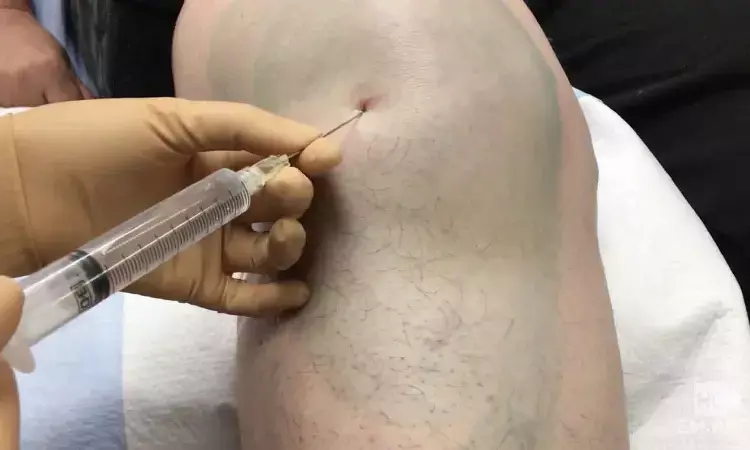- Home
- Medical news & Guidelines
- Anesthesiology
- Cardiology and CTVS
- Critical Care
- Dentistry
- Dermatology
- Diabetes and Endocrinology
- ENT
- Gastroenterology
- Medicine
- Nephrology
- Neurology
- Obstretics-Gynaecology
- Oncology
- Ophthalmology
- Orthopaedics
- Pediatrics-Neonatology
- Psychiatry
- Pulmonology
- Radiology
- Surgery
- Urology
- Laboratory Medicine
- Diet
- Nursing
- Paramedical
- Physiotherapy
- Health news
- Fact Check
- Bone Health Fact Check
- Brain Health Fact Check
- Cancer Related Fact Check
- Child Care Fact Check
- Dental and oral health fact check
- Diabetes and metabolic health fact check
- Diet and Nutrition Fact Check
- Eye and ENT Care Fact Check
- Fitness fact check
- Gut health fact check
- Heart health fact check
- Kidney health fact check
- Medical education fact check
- Men's health fact check
- Respiratory fact check
- Skin and hair care fact check
- Vaccine and Immunization fact check
- Women's health fact check
- AYUSH
- State News
- Andaman and Nicobar Islands
- Andhra Pradesh
- Arunachal Pradesh
- Assam
- Bihar
- Chandigarh
- Chattisgarh
- Dadra and Nagar Haveli
- Daman and Diu
- Delhi
- Goa
- Gujarat
- Haryana
- Himachal Pradesh
- Jammu & Kashmir
- Jharkhand
- Karnataka
- Kerala
- Ladakh
- Lakshadweep
- Madhya Pradesh
- Maharashtra
- Manipur
- Meghalaya
- Mizoram
- Nagaland
- Odisha
- Puducherry
- Punjab
- Rajasthan
- Sikkim
- Tamil Nadu
- Telangana
- Tripura
- Uttar Pradesh
- Uttrakhand
- West Bengal
- Medical Education
- Industry
Ultrasound guidance improves results of arthrocentesis of medium-sized joint effusions: Study

Ultrasound-guided (USG) is better than landmark-guided (LMG) medium-sized joint arthrocentesis, according to a recent study published in the Academic Emergency Medicine.
Joint and soft tissue injections are frequent procedures in rheumatological practice, but it is recognised that the success rate with which injections reach their intended target using anatomical landmarks as guidance is limited.1 High-resolution ultrasound (US) is a valid, "bed-side" imaging technique,2 which is increasingly used in rheumatological practice for diagnostic purpose, but also as image guidance for needle arthrocentesis to perform aspirations, injections or synovial biopsies
Arthrocentesis is commonly performed in the emergency department, but success rates vary based on location. Presently, there is a paucity of data assessing the utility of ultrasound-guided (USG) medium-sized joint arthrocentesis. The objective of this study was to compare the success of USG and landmark-guided (LMG) medium-sized joint arthrocentesis.
This was a single-centre, prospective, randomized clinical trial (NCT03327584) of a convenience sample of adult patients who presented to an urban, university hospital with > 105,000 visits annually. Patients with a suspected medium-sized joint effusion (defined as elbow, wrist, or ankle) undergoing arthrocentesis were randomized into LMG or USG using the GE Logiq e linear transducer (4–10 MHz). The following patients were excluded: on anticoagulation, with soft tissue infection overlying the joint, or involving an artificial joint. Statistical analysis included the Fisher exact, Mann-Whitney U-test, and t-test.
The results of the study are:
Overall, 44 patients were enrolled with 23 patients randomized into the LMG group and 21 patients into the USG arm. USG was significantly better than LMG with an overall success of 94.1% versus 60% for LMG (difference = 34.1%, 95% confidence interval [CI] = 4.90 to 58.83). USG first-pass success was 82.4% versus 46.7% for LMG (difference = 35.7%, 95% CI = 2.76 to 60.37) and a mean of 1.35 attempts versus 2.00 for LMG (difference = 0.65, 95% CI = 0.005 to 1.296). Of the 14 LMG failures, eight had no effusion present on USG crossover. Four patients in the USG group had no effusion present.
Thus, ultrasound guidance improved first-pass and overall successful arthrocentesis of medium-sized joint effusions.
Reference:
Ultrasound-versus landmark-guided medium-sized joint arthrocentesis: A randomized clinical trial by Ryan C. Gibbons et a. published in the Academic Emergency Medicine.
https://onlinelibrary.wiley.com/doi/10.1111/acem.14396
Keywords:
Academic Emergency Medicine, Ultrasound, landmark-guided, medium-sized joint arthrocentesis, arthrocentesis, Ryan C. Gibbons, Allison Zanaboni, Jessica Genninger, Thomas G. Costantino,
Dr. Shravani Dali has completed her BDS from Pravara institute of medical sciences, loni. Following which she extensively worked in the healthcare sector for 2+ years. She has been actively involved in writing blogs in field of health and wellness. Currently she is pursuing her Masters of public health-health administration from Tata institute of social sciences. She can be contacted at editorial@medicaldialogues.in.
Dr Kamal Kant Kohli-MBBS, DTCD- a chest specialist with more than 30 years of practice and a flair for writing clinical articles, Dr Kamal Kant Kohli joined Medical Dialogues as a Chief Editor of Medical News. Besides writing articles, as an editor, he proofreads and verifies all the medical content published on Medical Dialogues including those coming from journals, studies,medical conferences,guidelines etc. Email: drkohli@medicaldialogues.in. Contact no. 011-43720751


